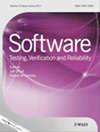Comparing the effectiveness of capture and replay against automatic input generation for Android graphical user interface testing
IF 1.2
4区 计算机科学
Q3 COMPUTER SCIENCE, SOFTWARE ENGINEERING
引用次数: 12
Abstract
Exploratory testing and fully automated testing tools represent two viable and cheap alternatives to traditional test‐case‐based approaches for graphical user interface (GUI) testing of Android apps. The former can be executed by capture and replay tools that directly translate execution scenarios registered by testers in test cases, without requiring preliminary test‐case design and advanced programming/testing skills. The latter tools are able to test Android GUIs without tester intervention. Even if these two strategies are widely employed, to the best of our knowledge, no empirical investigation has been performed to compare their performance and obtain useful insights for a project manager to establish an effective testing strategy. In this paper, we present two experiments we carried out to compare the effectiveness of exploratory testing approaches using a capture and replay tool (Robotium Recorder) against three freely available automatic testing tools (AndroidRipper, Sapienz, and Google Robo). The first experiment involved 20 computer engineering students who were asked to record testing executions, under strict temporal limits and no access to the source code. Results were slightly better than those of fully automated tools, but not in a conclusive way. In the second experiment, the same students were asked to improve the achieved testing coverage by exploiting the source code and the coverage obtained in the previous tests, without strict temporal constraints. The results of this second experiment showed that students outperformed the automated tools especially for long/complex execution scenarios. The obtained findings provide useful indications for deciding testing strategies that combine manual exploratory testing and automated testing.在Android图形用户界面测试中比较捕获和重放与自动输入生成的有效性
对于Android应用程序的图形用户界面(GUI)测试,探索性测试和全自动测试工具代表了传统的基于测试用例的方法的两种可行且廉价的替代方案。前者可以通过捕获和重放工具来执行,这些工具可以直接转换测试人员在测试用例中注册的执行场景,而不需要初步的测试用例设计和高级编程/测试技能。后一种工具能够在没有测试人员干预的情况下测试Android gui。即使这两种策略被广泛采用,据我们所知,还没有进行实证调查来比较它们的性能,并为项目经理建立有效的测试策略获得有用的见解。在本文中,我们提出了两个实验,以比较使用捕获和重播工具(Robotium Recorder)和三种免费的自动测试工具(AndroidRipper, Sapienz和Google Robo)的探索性测试方法的有效性。第一个实验涉及20名计算机工程专业的学生,他们被要求在严格的时间限制下记录测试执行情况,并且不能访问源代码。结果略好于全自动工具,但不是决定性的。在第二个实验中,同样的学生被要求在没有严格时间限制的情况下,通过利用源代码和在之前的测试中获得的覆盖率来提高获得的测试覆盖率。第二个实验的结果表明,学生的表现优于自动化工具,特别是在长/复杂的执行场景中。获得的发现为决定结合手工探索性测试和自动化测试的测试策略提供了有用的指示。
本文章由计算机程序翻译,如有差异,请以英文原文为准。
求助全文
约1分钟内获得全文
求助全文
来源期刊

Software Testing Verification & Reliability
工程技术-计算机:软件工程
CiteScore
3.70
自引率
0.00%
发文量
34
审稿时长
>12 weeks
期刊介绍:
The journal is the premier outlet for research results on the subjects of testing, verification and reliability. Readers will find useful research on issues pertaining to building better software and evaluating it.
The journal is unique in its emphasis on theoretical foundations and applications to real-world software development. The balance of theory, empirical work, and practical applications provide readers with better techniques for testing, verifying and improving the reliability of software.
The journal targets researchers, practitioners, educators and students that have a vested interest in results generated by high-quality testing, verification and reliability modeling and evaluation of software. Topics of special interest include, but are not limited to:
-New criteria for software testing and verification
-Application of existing software testing and verification techniques to new types of software, including web applications, web services, embedded software, aspect-oriented software, and software architectures
-Model based testing
-Formal verification techniques such as model-checking
-Comparison of testing and verification techniques
-Measurement of and metrics for testing, verification and reliability
-Industrial experience with cutting edge techniques
-Descriptions and evaluations of commercial and open-source software testing tools
-Reliability modeling, measurement and application
-Testing and verification of software security
-Automated test data generation
-Process issues and methods
-Non-functional testing
 求助内容:
求助内容: 应助结果提醒方式:
应助结果提醒方式:


